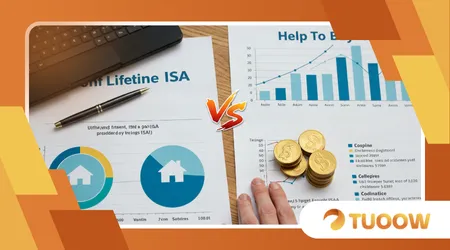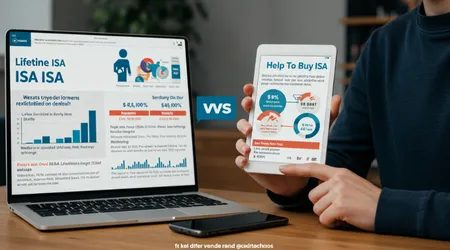Lifetime ISA vs. Help to Buy ISA: Key Differences in 2025

The decision to save for your first home in the UK can feel like navigating a financial maze, with options like the Lifetime ISA vs. Help to Buy ISA sparking debates among first-time buyers.
Both schemes, backed by the UK government, aim to help you climb the property ladder by offering a 25% bonus on savings.
But in 2025, with the housing market evolving and economic pressures shifting, which one truly suits your needs?
This article dives deep into the Lifetime ISA vs. Help to Buy ISA, dissecting their differences, weighing their pros and cons, and offering practical insights to guide your choice.
Whether you’re a young professional saving for a deposit or planning for retirement, understanding these schemes is crucial to maximising your savings.
The Lifetime ISA vs. Help to Buy ISA debate isn’t just about numbers it’s about aligning your financial strategy with your life goals.
Introduced in 2017, the Lifetime ISA (LISA) offers flexibility for first-time buyers and retirement savers, while the Help to Buy ISA, launched in 2015 but closed to new applicants in 2019, remains relevant for existing account holders.
With rising house prices (the average UK house price hit £293,000 in August 2025, per Halifax data) and interest rates fluctuating, choosing the right ISA can make or break your home-buying dreams.
This guide unpacks the nuances, from eligibility to penalties, with real-world examples and expert insights to help you decide.
What Are Lifetime ISAs and Help to Buy ISAs?
A Lifetime ISA allows those aged 18–39 to save up to £4,000 annually, earning a 25% government bonus up to £1,000 yearly until age 50.
You can use it for a first home (up to £450,000) or retirement, with cash or stocks and shares options. Withdrawals for other purposes before age 60 incur a 25% penalty, potentially leaving you with less than you invested.
The Help to Buy ISA, now closed to new savers, lets existing account holders save £200 monthly (plus a £1,000 initial deposit) until November 2029.
++ ISAs Explained: Which Type Is Right for You
It offers a 25% bonus, capped at £3,000, for homes up to £250,000 (£450,000 in London). The bonus applies only at purchase completion, not for deposits.
Both the Lifetime ISA vs. Help to Buy ISA share the 25% bonus, but their structures differ significantly.
LISAs offer higher annual contributions and broader property price limits, while Help to Buy ISAs provide flexibility for smaller savings without withdrawal penalties. Your choice depends on your savings capacity and timeline.

Key Differences Between Lifetime ISA and Help to Buy ISA
Eligibility and Accessibility
LISAs are open to UK residents aged 18–39, with contributions allowed until age 50. You must be a first-time buyer or saving for retirement to qualify.
Help to Buy ISAs, restricted since 2019, are only for existing account holders aged 16+, with contributions permitted until 2029 and bonuses claimable until 2030.
If you’re over 40, you can’t open a LISA, making the Help to Buy ISA your only option if you already have one. For younger savers, the Lifetime ISA vs. Help to Buy ISA tilts toward LISAs for their ongoing availability. Consider Sarah, 25, who opens a LISA to save £4,000 yearly, versus John, 45, stuck with his Help to Buy ISA.
Also read: Best UK Bank Accounts for Students and Young Professionals
The LISA’s age restriction reflects its dual purpose home buying and retirement while the Help to Buy ISA focuses solely on property. If you’re nearing 40, act fast to open a LISA. Why wait when time is your biggest asset?
Contribution Limits and Bonuses
You can save £4,000 annually in a LISA, earning a £1,000 bonus, paid monthly, which compounds with interest or investment growth.
Help to Buy ISAs allow £200 monthly (£1,200 initial deposit), with a £3,000 maximum bonus, paid only at purchase. LISAs offer higher potential bonuses over time.
For example, saving £4,000 yearly in a LISA for five years yields £5,000 in bonuses, while a Help to Buy ISA maxes out at £3,000.
The Lifetime ISA vs. Help to Buy ISA bonus structure favours LISAs for long-term savers. However, Help to Buy ISAs suit those with smaller monthly budgets.
Read more: Trends in sustainable finance in the UK: regulations and investment opportunities
The LISA’s monthly bonus payment means your savings grow faster, as interest accrues on the bonus too. In contrast, the Help to Buy ISA’s bonus delay limits its earning potential. If you’re saving over several years, the LISA’s structure is a clear winner.
Property Price Limits and Usage
LISAs allow purchases of homes up to £450,000 nationwide, making them versatile for pricier regions. Help to Buy ISAs cap at £250,000 (£450,000 in London), restricting options outside the capital. This makes the Lifetime ISA vs. Help to Buy ISA a critical choice for regional buyers.
Imagine Emma, eyeing a £300,000 home in Manchester. A LISA works, but a Help to Buy ISA doesn’t unless she relocates to London.
LISAs also require the account to be open for one year before use, unlike Help to Buy ISAs, which need only £1,600 saved.
The LISA’s higher price cap aligns with 2025’s rising property values, especially in urban areas. Help to Buy ISAs, while simpler, fall short for homes above £250,000 outside London, limiting their appeal in today’s market.
Withdrawal Flexibility and Penalties
Withdrawing from a LISA for non-qualifying purposes (not a first home or before age 60) triggers a 25% penalty, reducing your savings.
For example, £5,000 (including a £1,000 bonus) withdraws as £3,750. Help to Buy ISAs allow penalty-free withdrawals, though you lose the bonus.
This penalty makes the Lifetime ISA vs. Help to Buy ISA a riskier choice if your plans change. Help to Buy ISAs offer flexibility for savers unsure about home buying. Consider Tom, who withdraws £2,000 from his Help to Buy ISA for a car, keeping his full savings.
LISAs demand commitment, like planting a tree you can’t uproot without cost. Help to Buy ISAs, however, let you pivot without financial loss, making them safer for uncertain savers. Choose based on your confidence in buying a home.
Transferring Between ISAs
You can transfer Help to Buy ISA funds to a LISA, but they count toward the £4,000 annual LISA limit. For instance, transferring £3,000 leaves £1,000 for new contributions. Transferring from a LISA to a Help to Buy ISA incurs the 25% penalty, making it less viable.
The Lifetime ISA vs. Help to Buy ISA transfer rules favour moving to a LISA for long-term savers. If you have £5,600 in a Help to Buy ISA, spreading transfers over two years maximises bonuses. Check provider transfer policies to avoid delays.
This transfer option is a lifeline for existing Help to Buy ISA holders. However, the LISA’s one-year rule means planning is key. Always confirm with your provider to ensure smooth transitions and bonus eligibility.
Cash vs. Stocks and Shares Options
LISAs offer cash or stocks and shares options, with the latter carrying investment risks but potential for higher returns.
Help to Buy ISAs are cash-only, ensuring stability but lower growth. The Lifetime ISA vs. Help to Buy ISA choice hinges on your risk tolerance.
Stocks and shares LISAs suit long-term savers, like Priya, who invests £4,000 yearly and sees 5% annual growth.
Cash LISAs, like Tembo’s 4.1% AER (variable) in 2025, offer certainty. Help to Buy ISAs typically have lower rates, around 2.3% (Skipton Building Society).
Risk-averse savers prefer cash LISAs or Help to Buy ISAs for predictable returns. Stocks and shares LISAs appeal to those comfortable with market fluctuations, especially for retirement savings. Assess your financial goals before choosing.
Comparing Key Features: A Snapshot
| Feature | Lifetime ISA | Help to Buy ISA |
|---|---|---|
| Eligibility | 18–39, UK residents | 16+, existing accounts only |
| Contribution Limit | £4,000/year | £200/month + £1,000 initial deposit |
| Government Bonus | 25%, up to £1,000/year, paid monthly | 25%, up to £3,000, paid at purchase |
| Property Price Limit | £450,000 nationwide | £250,000 (£450,000 in London) |
| Withdrawal Penalty | 25% for non-qualifying withdrawals | None, but no bonus if not for home purchase |
| Account Type | Cash or stocks and shares | Cash only |
| Availability | Open to new savers | Closed to new savers since 2019 |
| Use for Retirement | Yes, penalty-free after 60 | No, home purchase only |
This table, sourced from MoneySavingExpert’s 2025 guide, highlights the Lifetime ISA vs. Help to Buy ISA distinctions.
LISAs offer greater flexibility and higher bonuses, but Help to Buy ISAs remain relevant for existing holders with smaller savings goals.
Which ISA Suits Your 2025 Goals?
Choosing between a Lifetime ISA vs. Help to Buy ISA depends on your timeline, savings capacity, and property goals. LISAs shine for long-term savers aiming for homes up to £450,000 or retirement planning.
Their higher contribution limits and monthly bonuses maximise growth, especially in stocks and shares LISAs, which averaged 7.2% returns in 2024 (per FCA data).
Help to Buy ISAs suit those with existing accounts, smaller monthly savings, or plans to buy soon. Their penalty-free withdrawals offer flexibility, ideal for savers unsure about committing to a home purchase. However, their £250,000 property cap (outside London) limits their use in 2025’s market.
For instance, Liam, 30, saves £4,000 yearly in a LISA, earning £1,000 bonuses annually, aiming for a £400,000 home in Bristol.
Conversely, Sophie, 28, with £6,000 in a Help to Buy ISA, plans to buy a £200,000 flat in Leeds, benefiting from penalty-free access if plans change. The Lifetime ISA vs. Help to Buy ISA choice hinges on your financial discipline and market realities.
Think of these ISAs as tools in a builder’s kit: a LISA is a versatile power drill, tackling bigger projects, while a Help to Buy ISA is a reliable hammer, perfect for smaller tasks. In 2025, with house prices climbing, LISAs generally offer more firepower for first-time buyers.
Making Your Decision in 2025
The Lifetime ISA vs. Help to Buy ISA debate boils down to your circumstances. Are you a young saver with years to spare?
A LISA’s higher bonuses and flexibility make it a no-brainer. Already holding a Help to Buy ISA and planning to buy soon?
Stick with it to avoid LISA penalties or delays. Always consult a financial advisor for tailored advice, especially for stocks and shares LISAs, where capital is at risk.
In 2025, with economic uncertainty and rising property costs, planning is key. LISAs offer a robust path for committed savers, while Help to Buy ISAs remain a safe bet for existing holders.
Whichever you choose, start saving now time is money, and the property ladder waits for no one.
Frequently Asked Questions
Can I have both a Lifetime ISA and a Help to Buy ISA?
Yes, but you can only use one bonus for a home purchase. Transfers from Help to Buy to LISA count toward the £4,000 limit.
What happens if I withdraw from a LISA for non-qualifying reasons?
A 25% penalty applies, reducing your savings. For example, £5,000 (with £1,000 bonus) withdraws as £3,750, assuming no investment growth.
Can I transfer my Help to Buy ISA to a LISA?
Yes, but transfers count toward the LISA’s £4,000 annual limit. Spread larger amounts over multiple years to maximise bonuses.
Which ISA is better for a quick home purchase?
Help to Buy ISAs are faster, requiring only £1,600 to qualify for a bonus, versus a LISA’s one-year minimum.
